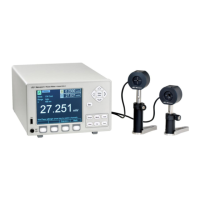126 Principles of Operation
9.10.4 Energy Detector Temperature Effects
Pyroelectric (Newport Energy) detectors are AC coupled devices and thus are
not susceptible to temperature induced DC signal offsets or noise floor
changes.
One generally does not need to take much precaution with pyroelectric
detectors except to make sure that their damage threshold is not exceeded.
9.10.5 Ambient and Stray Light
Ambient and stray light striking the detector should be considered when
making a measurement. Ambient light can be distinguished from dark current
(or the detector/meter noise floor) by either turning off or blocking the source
and covering the detector face with opaque material such as a piece of black
rubber.
Using the human hand to cover the detector is not advised because it emits a
significant amount of infrared radiation and radiates a temperature
significantly different from ambient. With the detector covered, a reading of
the dark current may be made. Next, remove the material that is covering the
detector and take another reading. The difference is the ambient light level.
The effects of ambient light are greatly reduce when using a fiber-
connectorized signal input to the detector. If free-space beam measurements
are desired, using an attenuator ( Low-Power detectors have an OD3
attenuator included ) will reduce stray light and often improve the source
signal to ambient signal noise level. Wavelength-specific filters, such as
optical cutoff, bandpass, or spike filters can also be used if the signal
wavelength spectrum permits. Other techniques to reduce stray light include
using apertures, placing detector in a box or other housing to shield the
surface from light ( or air currents when using Newport’s High-Power disk
thermopile detectors ) which is not coming from the source, and turning off
room and other light.
NOTE
Changes in ambient light levels can occur from such factors as turning room lights
on or off, or by moving people or equipment. Remember, if you can see your
detector element, then your detector can see the light bouncing off you.
The effects of ambient light are greatly reduced when using a fiber-connectorized
signal input to the detector. If free-space beam measurements are desired, using an
attenuator will often improve the signal to ambient signal noise level.
Wavelength-specific filters, such as optical cutoff, band pass, or spike filters can be
used if the signal wavelength spectrum permits. Other techniques to reduce stray
light include using apertures, placing the detector in a box or other housing to shield
the surface from light (or air currents) and turning off room and other polluting light
sources.

